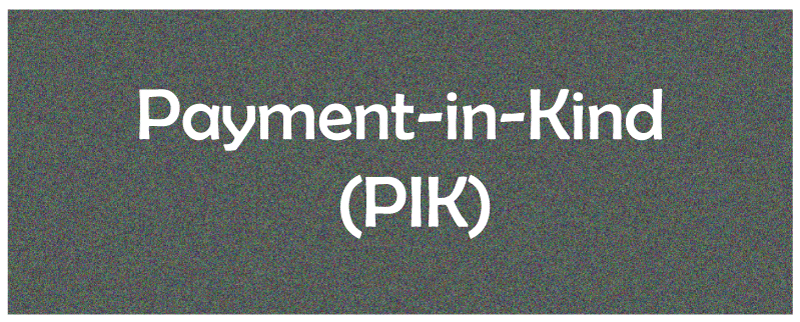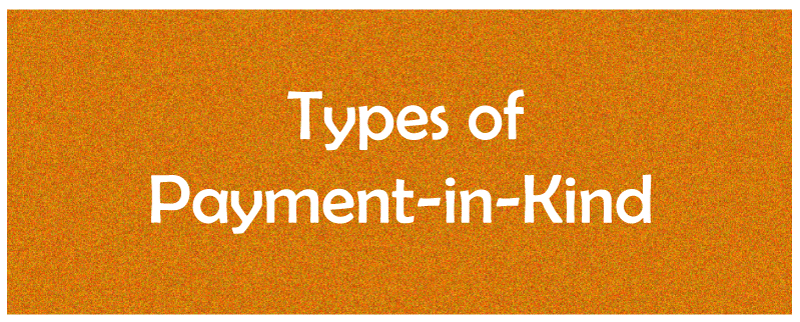Payment-in-Kind (PIK): What It Is, How It Works, Pros and ConsWhat is Payment-in-Kind (PIK)?Payment-in-kind (PIK) is when an item or service is used as payment in place of money. A financial instrument that pays interest or dividends to holders of "bonds", "notes", or "preferred stock" with additional securities or equities rather than cash is also called a "payment-in-kind". Payment-in-kind securities are popular in leveraged buyouts because they appeal to businesses that would rather avoid making cash expenditures. 
Understanding PIK Working ConceptPayment-in-kind securities fall under the mezzanine finance category and resemble debt and equity in some ways. They are regarded as riskier yet typically pay relatively high-interest rates. Payment-in-kind securities are most tend to be purchased by investors who are able to bear slightly high moderate risks, like hedge fund managers and private equity investors. With payment-in-kind notes, the issuer can postpone paying dividend payouts in cash in exchange for agreeing to offer a higher interest rate on the note. The financier constructs these notes so that they mature later than the firm's other debts, and in most circumstances, PIK notes make up a small portion of the overall outstanding debt of a firm. This increases the risk to the financier but enables the firm to concentrate on paying off conventional obligations or debts connected to cash distributions more swiftly. Most financiers include an early payment penalty to maximize their potential earnings to cover their risk. Accepting something instead of payment in cash is also referred to as "payment-in-kind". An illustration of payment-in-kind is a farm worker given "free" lodging and food instead of an hourly wage in exchange for working out on the farm. Types of Payment-in-Kind
Payment-in-kind instruments have developed to take a variety of shapes. These days, PIK contracts may include adjustable terms that change based on the macroeconomic environment or the borrower's preferences. The most typical forms of payment-in-kind agreements are listed below: TraditionalTraditional or true payment-in-kind contracts clearly define the terms for both cash and in-kind payments. This payment-in-kind agreement is the most common because the loan terms are predetermined. Timing expectations are stated in advance, along with the associated money amounts. Pay-If-You-CanPay-if-you-can contracts mandate that interest be paid in cash at predetermined intervals or according to a specified pattern. The borrower may decide to make a PIK interest payment if the requirements for interest payments are not met. This "pay-if-you-can" assessment is frequently made at a higher interest rate and only becomes effective if certain conditions or agreements are met (i.e., the capital available at a particular period was insufficient). Pay-If-You-LikePay-if-you-like contracts, also known as "toggle notes'' or "pay-if-you-want" agreements, offer the borrower (and occasionally the issuer) the freedom to choose the payment method. In many cases, the borrower can make a payment in cash, in-kind, or a mix of the two. With this arrangement, a borrower can continuously make interest payments on a bond or postpone them until the bond matures. If the borrower chooses to postpone making a cash payment and is instead charged interest for a payment-in-kind, the interest rate will be greater. Holdco Payment-In-KindSome loan agreements include a holding company level (a "Holdco") where debt repayment depends on the operating firm's cash flow. Any debt payments or principal repayments could depend on operating group distributions, each of which could have its own constraints. Holdco payment-in-kind agreements are typically risky since the downstream holding company may not be assured credit support from its parent firm. Pros and Cons of Payment-in-Kind (PIK)AdvantagesSince debt instruments can leverage a company's existing capital structure, businesses enter into payment-in-kind contracts. Companies may enter into these agreements if they are looking to avoid placing pressure on their cash flow. This is especially true for businesses with lengthy cash conversion cycles, which experience delayed inventory turnover and frequently prolonged capital encumbering. PIK contracts may also be flexible in several ways. First, payment-in-kind contracts might give the borrower a choice between cash payments and in-kind contributions. Additionally, covenants that favour one payment over another may be flexible. DisadvantagesPayment-in-kind contracts may be flexible, but they could also incentivize a business to keep putting off making payments. Companies might not be encouraged to adhere to financial covenants because failing to achieve some requirements could result in interest payments being postponed (which the company may find favourable). Assessments for in-kind payments are frequently subject to higher interest rates than payments made in cash. Even while a business may save money, it will still have to pay higher net charges that frequently need additional resources in the form of in-kind assessments. For instance, such hybrid deals can give the lender the option to purchase firm securities at a discount. While cash is preserved, the in-kind deal has eroded equity, and management has a small percentage of the firm's ownership. ExampleConsider a scenario where a banker provides a struggling business $2 million worth of payment-in-kind notes to explain how they work. The notes mature after 10 years and bear an interest rate of 10%. The interest on the note is $200,000 each year. However, the interest is added to the loan in kind, i.e., more debt, rather than being compelled to return that sum or any principal payments. As a result, the corporation owes $2.2 million at the close of the first year, and that sum keeps rising until the loan's maturity, at which point the cash is due. |
 For Videos Join Our Youtube Channel: Join Now
For Videos Join Our Youtube Channel: Join Now
Feedback
- Send your Feedback to [email protected]
Help Others, Please Share









